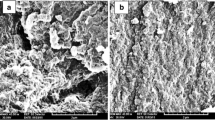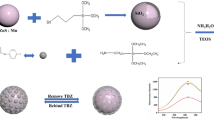Abstract
The authors describe a fluorescent probe for sensitive and selective determination of quercetin, an indicator for the freshness of drinks. The probe consists of silica ball encapsulated graphitic carbon nitride (g-C3N4) modified with a molecularly imprinted polymer (MIP). It was synthesized via reverse microemulsion. The resulting MIP@g-C3N4 nanocomposite was characterized by fluorescence spectroscopy, transmission electron microscopy, Fourier transform infrared spectroscopy, and X-ray powder diffraction. Quercetin quenches the fluorescence of the MIP@g-C3N4 probe. The effect was used to quantify quercetin in grape juice, tea juice, black tea, and red wine by fluorometry (λexc = 350 nm, λem = 460 nm). Response is linear in the 10–1000 ng mL−1 quercetin concentration range. The detection limit is 2.5 ng mL−1, recoveries range between 90.7 and 94.1%, and relative standard deviations are between 2.1 and 5.5%.

Schematic of the synthesis of the MIP@g-C3N4 by a reverse microemulsion method. The probe was applied for the selective recognition and fluorometric determination of quercetin.



Similar content being viewed by others
References
Nimse SB, Pal D (2015) Free radicals, natural antioxidants, and their reaction mechanisms. RSC Adv 5:27986–28006
Duan Q, Cao J, Zhang J (2012) Analysis of phenolic acids and their antioxidant activity by capillary electrophoresis-mass spectrometry with field-amplified sample injection. Anal Methods 4:3027–3032
Tu B, Liu ZJ, Chen ZF, Ouyang Y, Hu YJ (2015) Understanding the structure-activity relationship between quercetin and naringenin: in vitro. RSC Adv 5:106171–106181
Azzi J, Jraij A, Auezova L, Fourmentin S, Greige-Gerges H (2018) Novel findings for quercetin encapsulation and preservation with cyclodextrins, liposomes, and drug-in-cyclodextrin-in-liposomes. Food Hydrocoll 81:328–340
Berger LM, Wein S, Blank R, Metges CC, Wolffram S (2012) Bioavailability of the flavonol quercetin in cows after intraruminal application of quercetin aglycone and rutin. J Dairy Sci 95:5047–5055
Zafari S, Sharifi M, Chashmi NA (2018) A comparative study of biotechnological approaches for producing valuable flavonoids in prosopis farcta. Cytotechnology 70:603–614
Zhang HJ, Kang MQ, Zhang HQ, Yu Y (2014) Matrix solid phase dispersion extraction for determination of flavonoids in the flower of chrysanthemum morifolium ramat by capillary zone electrophoresis. Anal Methods 6:766–773
Yao Z, Yang X, Liu X, Yang Y, Hu Y, Zhao Z (2018) Electrochemical quercetin sensor based on a nanocomposite consisting of magnetized reduced graphene oxide, silver nanoparticles and a molecularly imprinted polymer on a screen-printed electrode. Microchim Acta 185:70
Zuo P, Xiao D, Gao M, Peng J, Pan R, Xia Y, He H (2014) Single-step preparation of fluorescent carbon nanoparticles, and their application as a fluorometric probe for quercetin. Microchim Acta 181:1309–1316
Wang Y, Bian F, Qin XF, Wang QQ (2018) Visible light photoelectrochemical aptasensor for chloramphenicol by using a TiO2 nanorod array sensitized with Eu (III)-doped CdS quantum dots. Microchim Acta 185:161
Tan L, Chen KC, Huang C, Peng RF, Luo XY, Yang R, Cheng YF, Tang YW (2015) A fluorescent turn-on detection scheme for alpha-fetoprotein using quantum dots placed in a boronate-modified molecularly imprinted polymer with high affinity for glycoproteins. Microchim Acta 182:2615–2622
Song YY, Xu GH, Wei FD, Cen Y, Sohail M, Shi ML, Xu XM, Ma YS, Ma YJ, Hu Q (2018) Aptamer-based fluorescent platform for ultrasensitive adenosine detection utilizing Fe3O4 magnetic nanoparticles and silver nanoparticles. Microchim Acta 185:139
Chen J, Chen Q, Chen J, Qiu H (2016) Magnetic carbon nitride nanocomposites as enhanced peroxidase mimetics for use in colorimetric bioassays, and their application to the determination of H2O2 and glucose. Microchim Acta 183:3191–3199
Hu YL, Yang DL, Yang C, Feng N, Shao ZW, Zhang L, Wang XD, Weng LX, Luo ZM, Wang LH (2018) A novel "off-on" fluorescent probe based on carbon nitride nanoribbons for the detection of citrate anion and live cell imaging. Sensors 18:1163
Zhou ZX, Shen YF, Li Y, Liu AR, Liu SQ, Zhang YJ (2015) Chemical cleavage of layered carbon nitride with enhanced photoluminescent performances and photoconduction. ACS Nano 9:12480–12487
Ren XH, Chen LG (2015) Quantum dots coated with molecularly imprinted polymer as fluorescence probe for detection of cyphenothrin. Biosens Bioelectron 64:182–188
Zhang L, Chen LG (2018) Visual detection of melamine by using a ratiometric fluorescent probe consisting of a red emitting CdTe core and a green emitting CdTe shell coated with a molecularly imprinted polymer. Microchim Acta 185:135
Ho WK, Zhang ZZ, Xu MK, Zhang XW, Wang XX, Yu H (2015) Enhanced visible-light-driven photocatalytic removal of NO: effect on layer distortion on g-C3N4 by H2 heating. Appl Catal B Environ 179:106–112
Amin N, Afkhami A, Hosseinzadeh L, Madrakian T (2018) Green and cost-effective synthesis of carbon dots from date kernel and their application as a novel switchable fluorescence probe for sensitive assay of Zoledronic acid drug in human serum and cellular imaging. Anal Chim Acta 1030:183–193
Yang SL, Li YR, Wang SF, Wang M, Chu MF, Xia BY (2018) Advances in the use of carbonaceous materials for the electrochemical determination of persistent organic pollutants. A review. Microchim Acta 185:112
Bian W, Zhang H, Yu Q, Shi MJ, Shuang SM, Cai ZW, Choi MM (2016) Detection of ag+ using graphite carbon nitride nanosheets based on fluorescence quenching. Spectrochim Acta A 169:122–127
Zhang YW, Liu JH, Wu G, Chen W (2012) Porous graphitic carbon nitride synthesized via direct polymerization of urea for efficient sunlight-driven photocatalytic hydrogen production. Nanoscale 4:5300–5303
Zhang XH, Gao RQ, Li DP, Yin HY, Zhang JL, Cao HY, Zheng XF (2015) Study on interaction between 5-Bromo-4-thio-2′-deoxyuridine and human serum albumin by spectroscopy and molecular docking. Spectrochim Acta A 136:1775–1781
Wang YQ, Zhang HM, Zhang GC, Tao WH, Tang SH (2007) Interaction of the flavonoid hesperidin with bovine serum albumin: a fluorescence quenching study. J Lumin 126:211–218
Li XW, Li CY, Chen LG (2015) Preparation of multifunctional magnetic-fluorescent nanocomposites for analysis of tetracycline hydrochloride. New J Chem 39:9976–9982
Ranjbari E, Biparva P, Hadjmohammadi MR (2012) Utilization of inverted dispersive liquid-liquid microextraction followed by HPLC-UV as a sensitive and efficient method for the extraction and determination of quercetin in honey and biological samples. Talanta 89:117–123
Rasoolzadeh F, Hashemi P, Serenjeh FN (2017) Ionic liquid-based cloud-point extraction of quercetin for its sensitive HPLC-UV determination in juice samples. Acta Chromatogr 29:1–4
Rajauria G (2018) Optimization and validation of reverse phase HPLC method for qualitative and quantitative assessment of polyphenols in seaweed. J Pharm Biomed Anal 148:230–237
Wang LC, Shangguan YN, Hou XD, Jia Y, Liu SJ, Sun YS, Guo Y (2017) Zinc oxide crystal whiskers as a novel sorbent for solid-phase extraction of flavonoids. J Chromatogr B 1060:91–96
Yola ML, Gupta VK, Eren T, Sen AE, Atar N (2014) A novel electro analytical nanosensor based on graphene oxide/silver nanoparticles for simultaneous determination of quercetin and morin. Electrochim Acta 120:204–211
Acknowledgments
This project was funded by the Fundamental Research Funds for the Central Universities (No. 2572017 EB08), Harbin science and technology innovation talent research special funds (2016RAQXJ151) and Natural Science Foundation of Heilongjiang Province (JJ2018ZR0081).
Author information
Authors and Affiliations
Corresponding authors
Ethics declarations
The author(s) declare that they have no competing interests.
Electronic supplementary material
ESM 1
(DOC 206 kb)
Rights and permissions
About this article
Cite this article
Xu, S., Chen, L. & Ma, L. Fluorometric determination of quercetin by using graphitic carbon nitride nanoparticles modified with a molecularly imprinted polymer. Microchim Acta 185, 492 (2018). https://doi.org/10.1007/s00604-018-3016-y
Received:
Accepted:
Published:
DOI: https://doi.org/10.1007/s00604-018-3016-y




